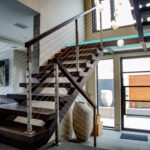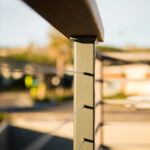Cable railing systems cost can vary widely depending on individual job specifics. Lineal footage, material selection, and a variety of other factors can contribute to the cost of your cable railing systems.
We receive numerous phone calls asking for ballpark lineal foot cost estimates which can vary greatly depending on the job. For budget preparation, the safest way to estimate a cable railing installation is to include as much detail (measurements, photos, stops, starts) as possible.
Below is a brief summary of some common factors relating to “cable railing systems cost” :
Framing Materials
Wood framing is typically the least expensive way to construct a cable railing. Wooden posts and railings can be sourced easily and usually locally. For semi-skilled, or DIY installers, wood framing can be easier to work with and less painful to the pocket book if a mistake is made.
Steel Framing is typically more expensive than wood framing. Different companies offer different systems typically made from steel, stainless steel, or aluminum. Steel cable railing kits can be easy to install; however the materials are usually pre finished so mistakes can be more costly. Although the cost base is higher; stainless steel framing is likely the top choice among professionals for railing post materials. The cost can be offset by utilizing a wooden or hardwood top railing for a durable and cost effective railing frame.
Lineal Footage
The longer a cable can be spanned, the lower the cable cost will be. The larger the railing project and amount of lineal footage, the lower the actual lineal foot cost should be. Avoiding starts and stops by planning your deck layout properly can save thousands of dollars in the long run. Smaller jobs like stairs are surprisingly expensive in relation to size. For example a 4’ stairway with rails on two sides will require two completely separate runs of railings and cable. The cable cost on this stairway example will exceed a 12 by 12’ deck on a continuous run. Utilizing two post corners (link other blog) can be a great way to cut cable cost and run cables over longer distances. Running stairs down the side of your deck vs. a perpendicular stairway that intersects the deck can also be a great way to cut cable cost.
Labor Cost
Although some industry pricing standards exist; labor cost for installing cable railings will also vary depending on the individual project details. DIY cable railings, doing it yourself, can save tremendous cost if the project can be completed successfully. Deck railings, straight runs, and minimally elevated structures are good DIY candidates.
Custom railings, interior cable railings, stairs, and on site fabrication will usually increase the cost for installation, and the possibility of needing a professional installer. Hiring a cable railing professional will usually be less expensive than making a mistake, or taking a chance on a professional with no previous experience. As cable railings become more popular, more options become available for materials and installers. Hiring a proven installer with cable railing installation experience can actually lower your cable railing systems cost by saving time or avoiding possible errors.
If you would like a cost estimate for cable railings please visit the quote request page or call our sales/estimation team at 844-277-7327.
Cable Railing Systems Cost




